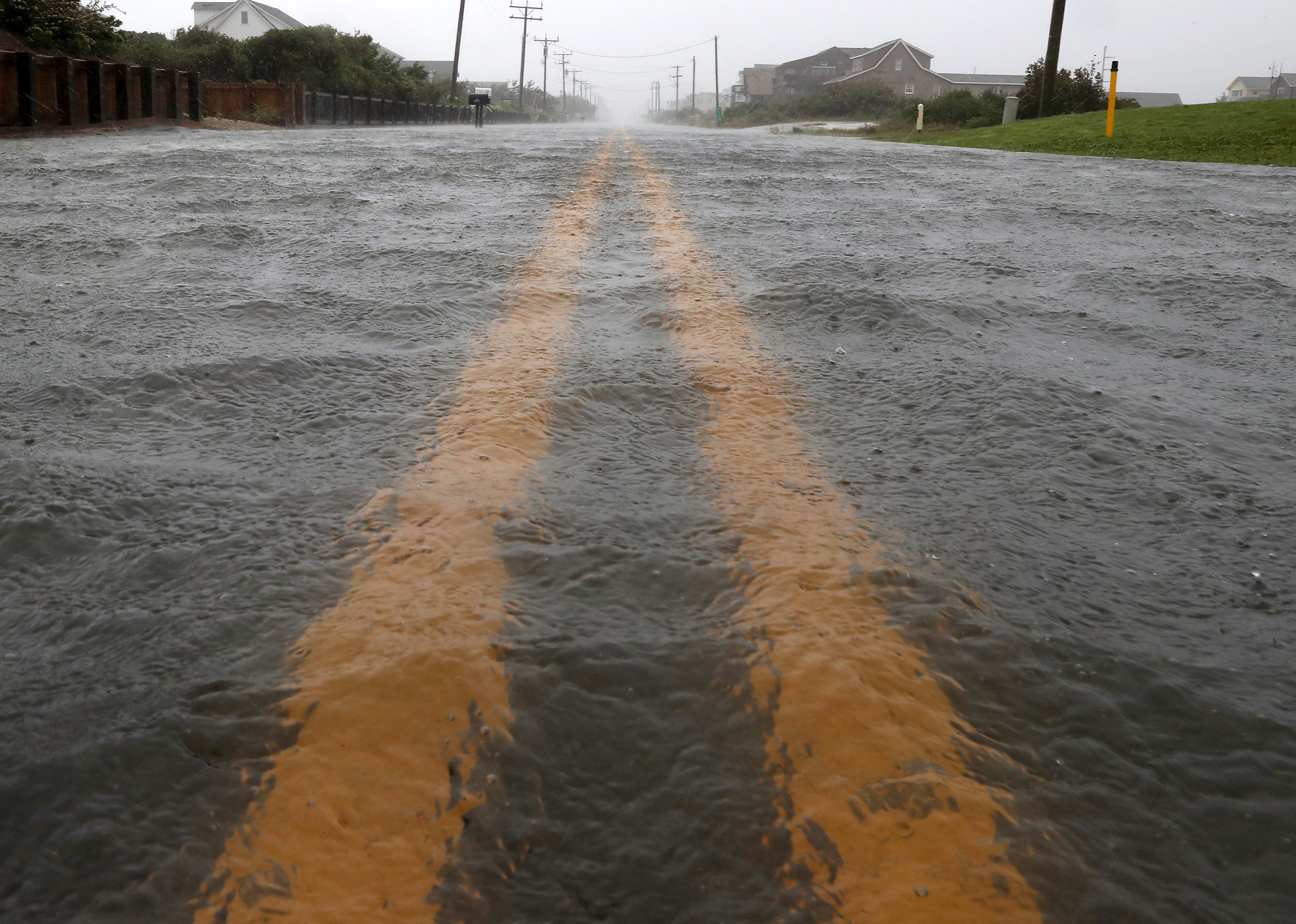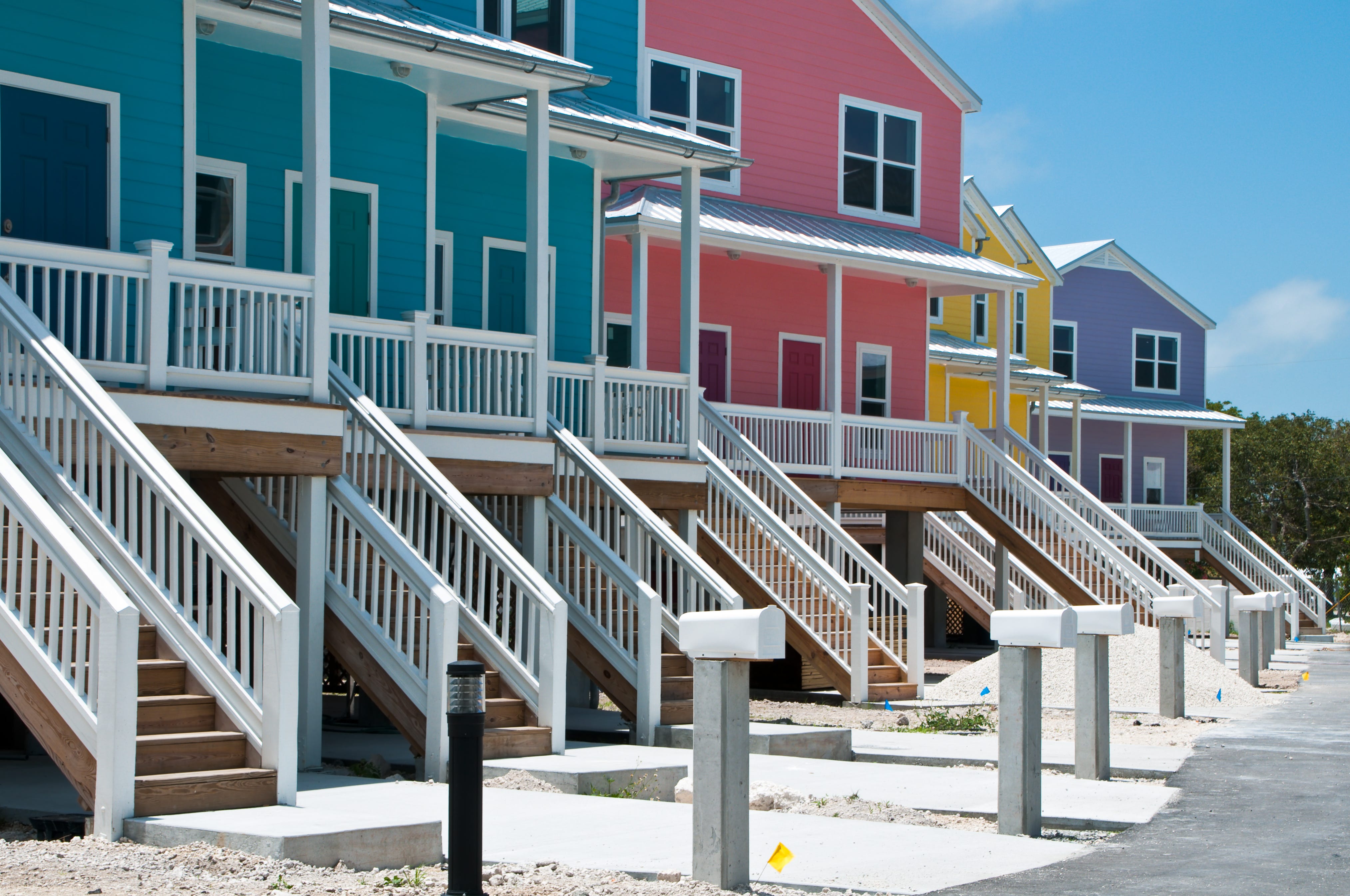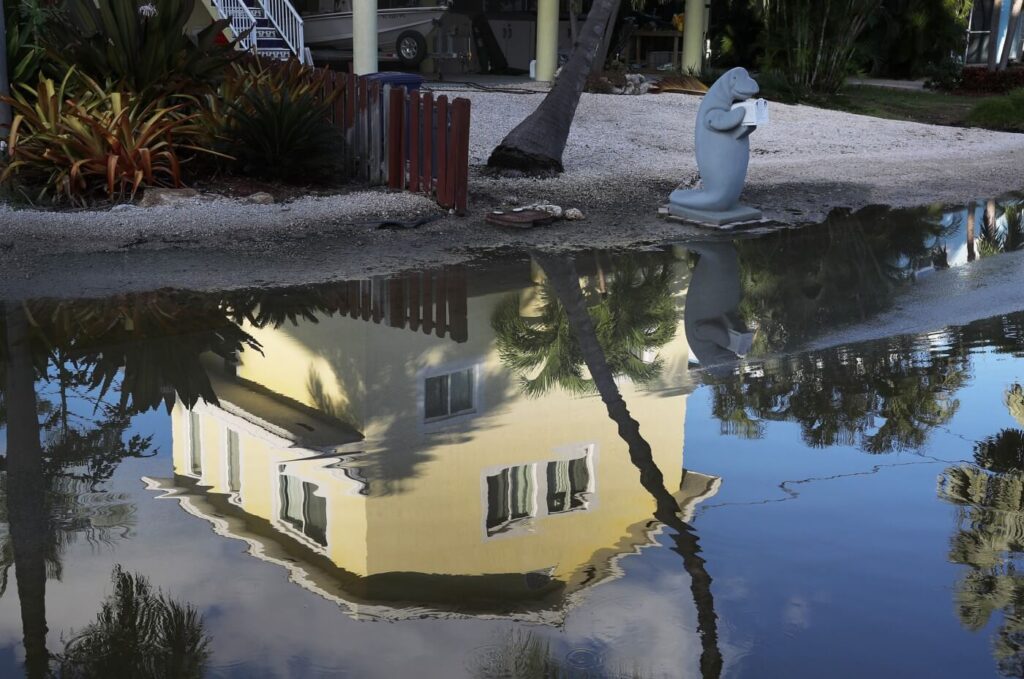Strategies for keeping property values afloat

Most people understand the high cost of preparing for and recovering from major flooding events, but research shows that even small amounts of tidal or rainfall flooding can meaningfully affect property values and economic activity. (For more background, see our recent article on property values and flooding.) If left unaddressed, flooding will harm property values in coastal and inland communities of all sizes across the United States.
Although local leaders can take many actions to protect property values from flooding, leaders at the state and federal level must also take significant steps to fully address the issue. Flooding impacts each community differently and these solutions aren’t one size fits all. In this article, we highlight three strategies that a community can take to protect property values, save residents money on flood insurance, and reduce the likelihood of flooding. Those strategies include maintaining safe and accessible roads, taking advantage of flood insurance premium savings, and incorporating flood adaptation into design and planning.
Resilient roads
For many homebuyers, access to well-maintained and reliable roads is a top priority when considering purchasing a home. If nearby roads flood, homes may be valued less than a comparable property without flood risk — even if the home itself doesn’t directly experience flooding. In many cases, local governments are responsible for roads and rights-of-way and can make infrastructure improvements. By maintaining accessible and safe roads, local leaders also bolster local property values.
From 2005–2016 in Miami-Dade County, homes near roads that experience tidal flooding lost roughly $3.70 per square foot of living area in annual property value growth, according to research published in 2018.
The City of Miami Beach, Florida, has employed multiple strategies to reduce flooding on city roads and protect property values. The City hired an interdisciplinary team that found that home prices are higher when surrounded by elevated roads, ranging from 4.9–14.1% in higher price per 1 foot of road elevation. The benefits exist even for condominiums. For example, the Sunset Harbour condominiums in Miami Beach increased in value by an estimated 11.9%, or approximately $41.2 million, following a nearby road elevation project.
Strategies for resilient roads
Communities have several ways to incorporate flood mitigation into their road design and upgrades. The following examples can be implemented gradually if budget constraints require, building up resilience over time.
- Protective barriers, such as berms or seawalls, can minimize floodwater runoff from higher elevations and/or higher river or ocean water levels. Communities can seamlessly integrate these barriers into new or existing roads. When considering building a seawall to protect a road from flooding, communities should look at how both publicly and privately owned seawalls could be affected (for further information, head to our guide on seawall elevation). To ensure that water isn’t left standing, municipalities should also consider adding new or enhancing existing stormwater drainage pumps and systems.
- Stormwater storage and drainage systems are important pieces of a flood resilient road strategy. To reduce standing water and maintain dry roads, investing in stormwater pump systems can be a costly but worthwhile undertaking. Communities should also look at ways to use roadside landscaping and bioswales to absorb and/or channel floodwaters and runoff from transportation routes. Not only does this green infrastructure reduce floodwaters on roadways, it also replenishes aquifers.
- Elevating roads to minimize standing water depth is another strategy to enhance flood resilience and protect property values. Municipalities that lack immediate funding or capacity to elevate large sections of road can more gradually build resilience by making elevating a necessary step for all future road projects.
- Permeable paving materials can provide a paved surface for walking or driving while also enabling water to drain into the ground. The City of Chicago has incorporated permeable pavement, permeable concrete, and/or pavers on high-use streets, in one case reducing stormwater runoff by 80% for a 1.5-mile project. The City’s Green Alley Program reduces flooding and avoids the costs of building new connections to sewer and stormwater drainage systems, specifically in back alleys.
Resilient roads in action: Sea Isle City, New Jersey
Sea Isle City, New Jersey, with a population of 2,000, is an example of a small community focused on addressing its roadside flooding with a combination of seawalls and berms. The City has elevated the main access road by 4.5 feet and has installed additional pumping stations. The City’s proactive steps earned it a higher Community Rating System (CRS) score (see next section for more info), entitling many local property owners to a 35% discount on flood insurance premiums.
When proactively addressing the risk of road flooding, each community must decide what solution best suits its needs. For example, communities should always consider geology and groundwater levels when planning for floods, both of which may influence flood risk and solutions.

Lowering flood insurance costs with CRS
To reduce the potential impact of flood insurance costs, local leaders can enroll their municipality in a Community Rating System (CRS) program.
Established by the Federal Emergency Management Agency (FEMA), the CRS program gives local communities credit for actions taken to reduce flood risk, through direct reductions in federal flood insurance premiums. Because FEMA implements the vast majority of homeowner flood insurance policies in the U.S. via the National Flood Insurance Program (NFIP), CRS participation allows local leaders to deliver flood insurance cost reductions directly to most, if not all, residential flood insurance policyholders in their community.
Flood insurance premiums are already a recognized financial burden for some homeowners and are expected to rise for some communities. The CRS program is, therefore, an important tool for municipalities to reduce cost burdens for current homeowners and to encourage homebuyers to invest in real estate in the future.
To be eligible to enroll in CRS, your community needs to already be part of the NFIP and meet the minimum NFIP floodplain management requirements. As of this year, only 7% of communities eligible to enroll in CRS are currently enrolled. With limited effort, many communities can enroll in CRS and start receiving credits and insurance premium reductions.
Steps to joining CRS
Participating in CRS is voluntary and has no application fee. To join, communities can follow the steps below:
- Submit a letter of interest to your FEMA Regional Office and verify good standing with the NFIP
- Appoint a CRS coordinator to serve as a liaison between FEMA and your municipality
- Collect documentation of existing floodplain management activities that add up to at least 500 CRS credit points. Many small communities have found that an assessment of existing or completed efforts and a few small new initiatives provide sufficient credit points to join.
For more information on enrollment, visit FEMA’s website and NFIP CRS Brochure. A sample letter, assessment tool, and additional resources can be found on the CRS Resources website.
Simple ways to earn CRS credits
While many actions to enhance flood adaptation are expensive and time-consuming, communities can also take lower-cost actions to qualify for CRS credits. The following actions are easy ways communities can start to build savings for residents.
- Invest in public education. For example, mailing a brochure about flood insurance to residents in a floodplain and putting up flyers about flood emergency procedures are simple, effective ways to simultaneously gain CRS credits and educate community members.
- Take an inventory of open space, or land that is free from buildings or development (which can harm floodplain functions), is a great step to identify existing efforts that count for CRS credits. Examples of open space include parks, nature preserves, and low-density zoning areas. Fewer or no structures in flood-prone areas reduces the amount of property damage from future flooding. Communities can gain a high number of points just by identifying open space in their floodplain.
- Build partnerships with diverse stakeholders. Forming a committee with community members, business leaders, and non-profit organizations is an important move to develop more comprehensive floodplain management plans. These partnerships allow for meaningful engagement in the planning process and receive CRS credit.
CRS in action: Cutler Bay, Florida
The Town of Cutler Bay, Florida, is an example of how smaller municipalities can prioritize flood resilience and maximize savings for residents. With a population of over 44,000 and a budget of $55 million, Cutler Bay is one of only three municipalities in the state of Florida and one of only 17 municipalities in the country, including Sea Isle City, New Jersey (see above), at CRS Class 4 or better. The Town’s CRS rating allows many residents and local businesses to save 30% on flood insurance premiums, saving policyholders an average of $243 per year. The Town achieved this rating through a combination of low-cost actions, like distributing flood educational materials, along with higher-cost efforts, like updating stormwater infrastructure and purchasing land for flood mitigation.
Enrolling in CRS and finding ways to get credit for things your municipality is already doing is the first step in minimizing flood insurance costs for homeowners and homebuyers. The next step is building a long-term plan to incorporate higher-impact flood adaptation actions into your municipal strategy and budget. Flood insurance rates may not be the same in the future, and communities need to take advantage of ways to reduce rates and build flood adaptation to be in the best possible situation should rates change.
Resilient planning and design steps to improve property values
Municipalities can take many actions to adapt to flooding and protect property values through design and planning. Municipal leaders can take these steps with mechanisms like municipal building ordinances and capital improvement planning and projects.
Designing open space
Designing and prioritizing open space is a way for municipal leaders to protect property values from flood impacts. Research has shown that nearby parks and other forms of open space increase property values within a neighborhood. Communities can also include design elements such as bioswales, rain gardens, and permeable pavement to absorb excess water and lessen flood impacts on surrounding roads and properties.
Local leaders can also encourage open space by issuing a municipal ordinance to incentivize or require open space for new development or by including the purchase or conversion of land to open space as a part of the city budget. Case studies have shown that communities that prioritize open space through this program have saved an average of $200,000 in property damage due to flooding. Open space also counts towards CRS credits.
Another way municipal officials can create open space is by encouraging homeowners to participate in voluntary buybacks of flood-prone properties. Individual homeowners can work with their local government to apply for FEMA’s acquisition program. This program compensates homeowners, removes existing structures, and requires these spaces to be preserved for “open space, recreational, or wetland management uses.” For properties that are repeatedly damaged by floods, voluntary buybacks are an important option for homeowners to consider.
Elevating Structures
Municipal leaders can also look at ways to incentivize the elevation of existing buildings and require new construction to build to higher elevations. Both actions make homes safer from floodwaters while increasing property value. Research from Miami Beach, Florida, has shown that home prices increase by 3.6% per additional foot of first-floor elevation.
Not only does building to a higher elevation make a property more financially valuable, but it also saves the homeowner from future costs of flood damage. In Houston, Texas, data analysis determined that building new homes to an elevation of 2 feet higher than the 500-year flood elevation would cost between $11,000 and $32,000 per home but save homeowners from flood damage costing $50,000 or higher.
A mechanism for municipal leaders to require higher building elevations is a city ordinance. Municipal leaders can strengthen existing ordinances and regulations to require that new properties build to higher elevations with greater freeboard.
Incorporating flood risk and adaptation methods into municipal planning and design has been shown to benefit property values and improve the confidence of homebuyers and rating agencies. Prioritizing and addressing flood risk demonstrates a commitment to resilience. Standard & Poors and Moody’s Investor Service cited these actions as the reason for continued high bond ratings for the City of Miami Beach and are incorporating them into Moody’s credit analyses.

These tactics are just some of the many ways municipalities can incorporate flood mitigation into their city strategy, while still encouraging economic growth and housing market success. We will continue to highlight ways municipalities can prepare for flooding while considering property values.
This article was authored by Annabel Cryan, Coalition Outreach Associate, with Lauren Kim, Summer Outreach Intern.






